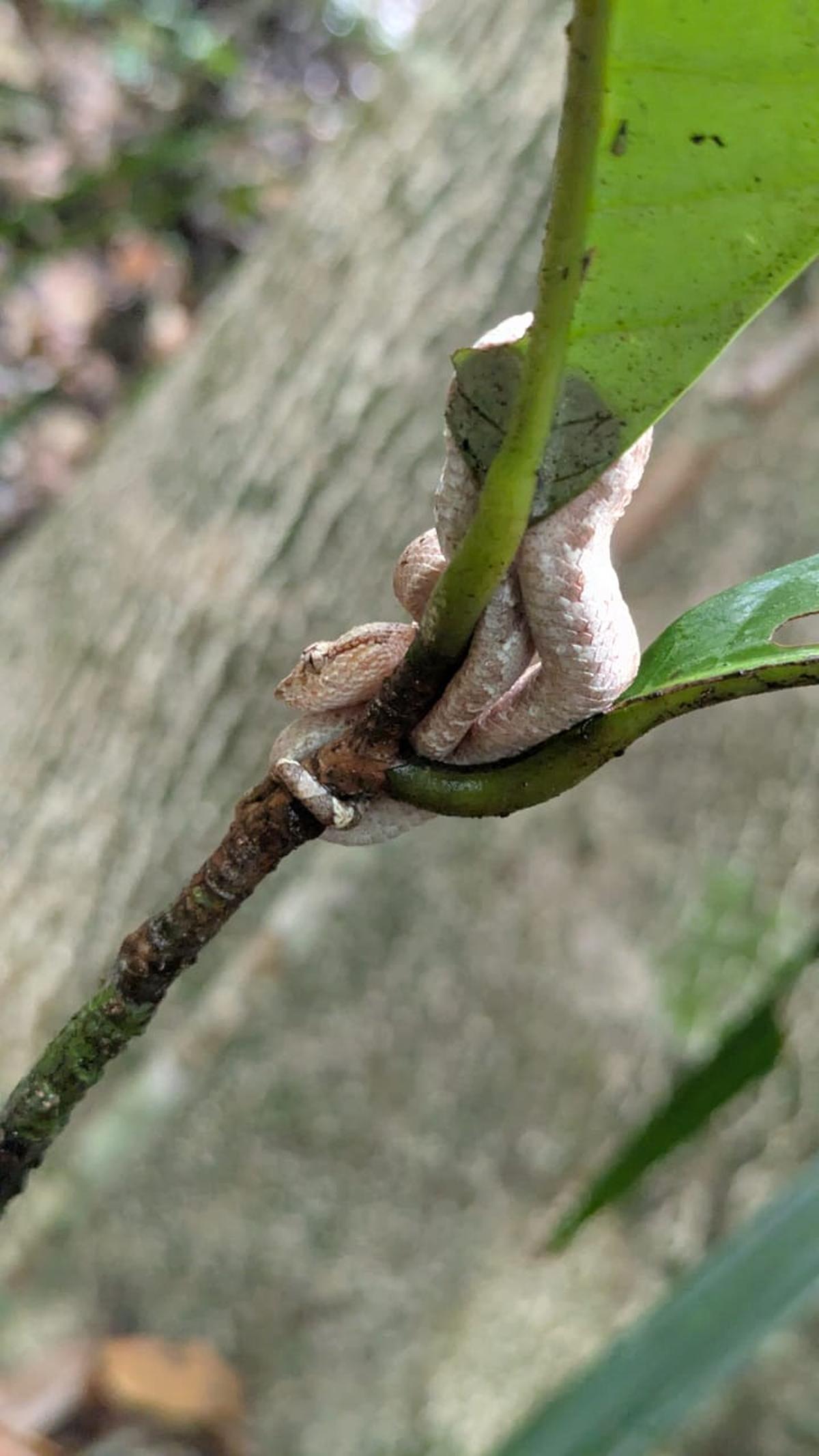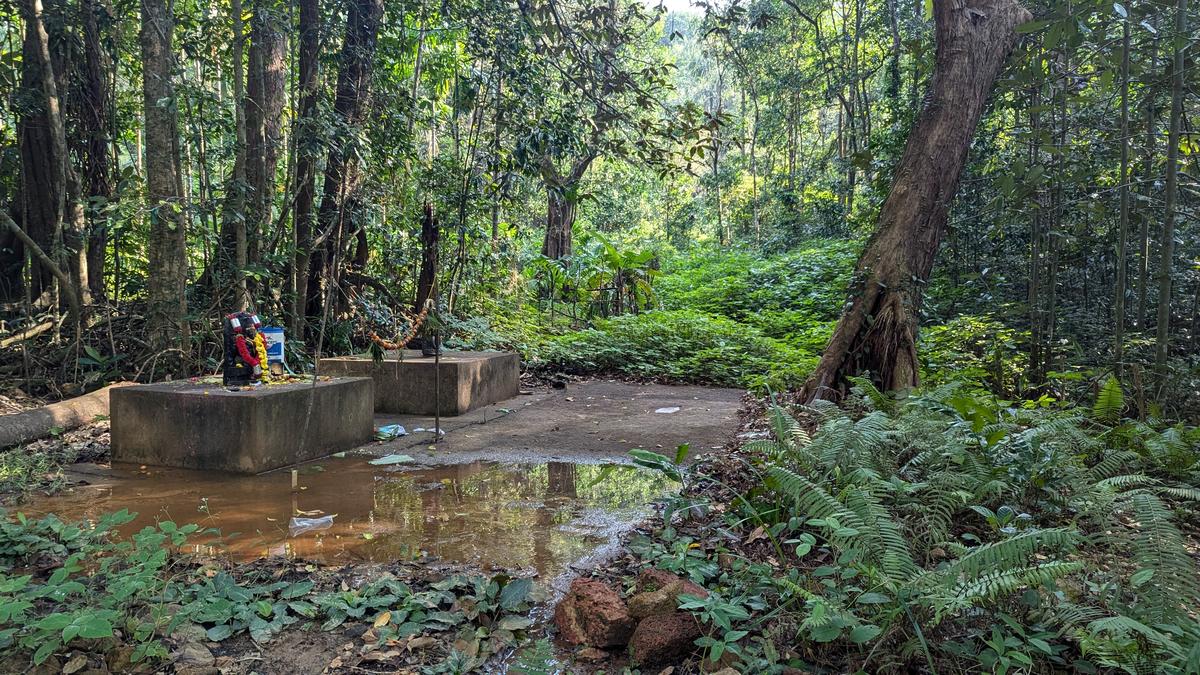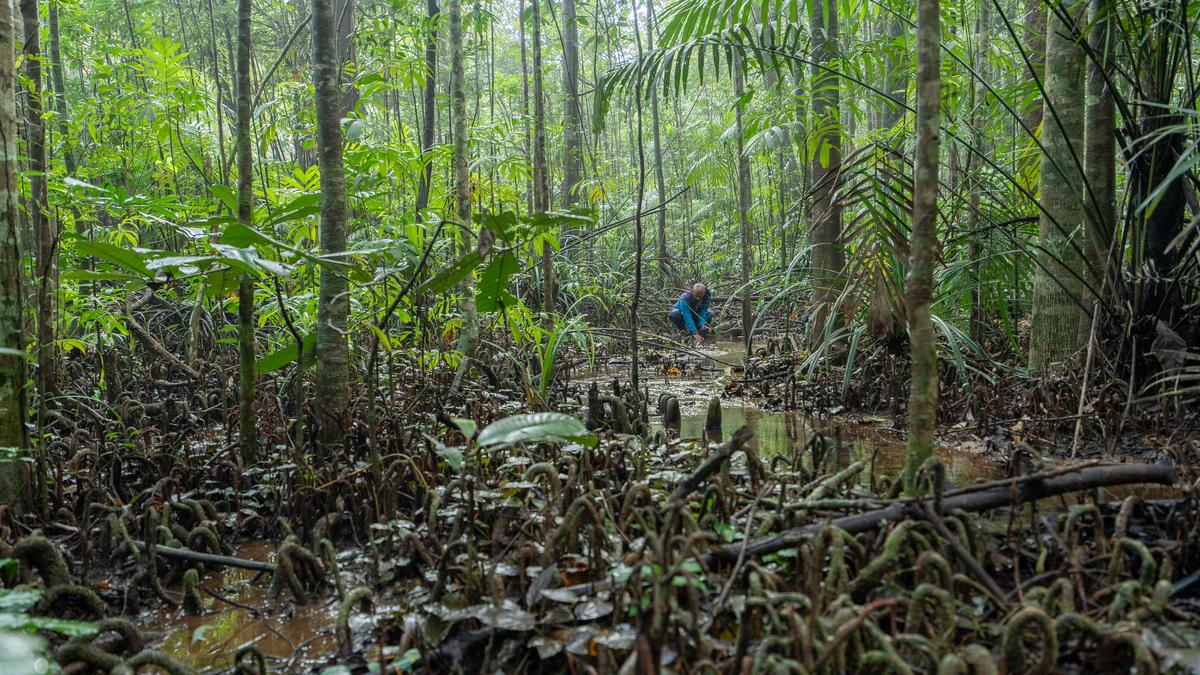Priya Ranganathan’s first encounter with a Myristica swamp was back in 2019 when she was working as a research assistant at the Bengaluru-based Ashoka Trust for Research in Ecology and the Environment (ATREE) on a hydro-ecology project. As part of a field trip with other researchers, she was exploring the Aghanashini, one of the rivers that flows through Sirsi taluk in Uttara Kannada district.
“We trekked quite a distance into one of these swamps,” she says, recalling that since it was during the monsoons, there was a heavy mist all over the landscape. “I remember thinking that it was so incredibly cool: a Malabar pit viper was lying there, roots everywhere, frogs were croaking, the mist was so low…it looked like a lost world,” says Priya, who has since closely studied this unique ecosystem and has just come out with a book titled The Dark Forest: An Illustrated Guide to the Biodiversity of the Myristica Swamps.
Priya Ranganathan, author of The Dark Forest: An Illustrated Guide to the Biodiversity of the Myristica Swamps
| Photo Credit:
Special arrangement
Her interest, piqued during this first encounter, deepened as she began studying these swamps as part of a project she was working on with ATREE researchers Dr G. Ravikanth and Dr N.A. Aravind. The time she spent reviewing literature on these swamps, talking to people who had worked in these places, and writing a manuscript based on this work, “made me interested in scientifically assessing swamps as a system,” says Priya, who eventually started her PhD on the subject, which she is currently pursuing at ATREE with Dr Ravikanth and and Dr. Jagdish Krishnaswamy, Dean, School of Environment and Sustainability (SES), Indian Institute for Human Settlements (IIHS). “That is how the journey took off, and I have not looked back since then.”
A primaeval world
Myristica swamps are unique, freshwater swamp ecosystems found in certain parts of the Western Ghats, “one of the least studied and most endangered wetland ecosystems in the country,” writes Priya in The Dark Forest, going on to describe them as “relic ecosystems, remnants of an ancient landscape that once stretched across the river valleys of the Western Ghats.”

A Malabar pit viper coils around a sapling, awaiting potential prey.
| Photo Credit:
Priya Ranganathan
These swamps, which mostly occur along the ”upper reaches of river systems within wet evergreen forest watersheds” and rely on “monsoon rainfall and seasonal flooding to sustain their unique hydrological cycle,” are named after the dominant trees in this landscape, which belong to the Myristica or nutmeg family, one of the oldest flowering plant groups in the world. “The exact dating of these landscapes hasn’t been done yet, but fossils resembling the Myristica seeds and leaves have been found dating back to the Early Cretaceous period,” she says, referring to a period around 145 to 100.5 million years ago, when the earth’s landmass was still only two continents, Gondwana and Laurasia, with dinosaurs roaming across them.
While there are five species of Myristica trees found in the Western Ghats today, not all of them are adapted to be in swamp conditions, she says. “Some are found in upland forests, but there are two species, Gymnacranthera canarica and Myristica fatua, which have evolved to have knee and stilt roots. This allows them to breathe in waterlogged conditions,” she says, adding that these trees also have lenticels or small pores on the surface of their roots to further help with respiration.
Multiple species
In addition to these trees, the Myristica swamps, which are found scattered across Karnataka, Kerala, Goa and Maharashtra, are home to many other forms of plant life, with around 90 species of herbaceous plants, 46 species of shrubs, 27 species of climbers and lianas and 80 species of trees, states The Dark Forest. It also supports a wide variety of animals, many of which are endemic to the Western Ghats, such as the lion-tailed macaque, Malabar giant squirrel, the rare Myristica Bambootail damselfly only found in these swamps, the critically endangered Kottigehar dancing frog and the Malabar grey hornbill. Also, “apart from being hotspots of unique biodiversity in the Western Ghats, Myristica swamps also provide various ecosystem services to local communities living near them,” explains Priya.

Some swamps are sacred groves where people have worshipped for generations, helping preserve these spaces.
| Photo Credit:
Priya Ranganathan
Not only do the swamps replenish the groundwater table and retain surface water and help regulate air temperature even during the summer months, but also, “much like other wetlands, they prevent downstream flooding by slowing the flow of water and allowing it to infiltrate into their soils,” she says. Some swamps also have immense cultural significance, serving as sacred sites for local communities who guard and look after them because of this. “Deities such as Chowdamma (the water goddess) and Hulidevaru (the tiger god) are worshipped in the form of stone statues placed within the dark swamp forests in Uttara Kannada district, Karnataka,” says Priya.
Threats and challenges
Despite the uniqueness and importance of these Myristica swamps, not enough attention has been paid to them, unlike coastal wetlands like mangroves, whose role in coastal protection, biodiversity support and ecosystem services is much better known. “The reason we talk so much about mangroves is that they are easily accessible,” she says.

Arecanut plantations are a major threat to Myristica swamps in Uttara Kannada.
| Photo Credit:
Priya Ranganathan
Besides being poorly understood, or perhaps because they are so poorly understood, Myristica swamps are under threat due to the ongoing climate crisis, which leads to rising temperatures and changing rainfall patterns, as well as human activities, she says. “In Uttara Kannada, the biggest threat is areca nut plantations and paddy fields, both water-intensive crops.”
Since these Myristica swamps offer a sustained water source, even during the dry months, people sometimes encroach and plant crops in and around them, destroying the ecosystem. “Another issue is of people extracting water from the swamp,” she says. “That changes the growth of the seeds and seedlings. Older trees may survive without much water, but the young, growing seedlings are badly affected.”
While the Karnataka Forest Department has been actively working on restoring and raising awareness about swamps, they continue to be managed as forests, a classification that, in Priya’s opinion, needs to be changed for better conservation strategies. “A swamp is a wetland and not just a forest. Water is what rules in a swamp; it is not just about trees being present,” she says. “I feel that, in order to successfully conserve swamps and market them as unique systems to people, you need to market them as wetlands, not forests.”
Awareness first
Priya says that the kernel of the idea for The Dark Forest first cropped up around 2022, when she received her first fieldwork grant. “As part of fieldwork, we have a lot of outreach components in these grants, and I had to come up with outreach material and do some workshops in local schools in the landscape,” she says. Since she is not a native speaker of Kannada, she started relying a lot on visual cues, “something creative that would bond them to the system without having to rely on my poor diction and vocabulary,” says Priya.
To do that more effectively, she reached out to her cousin, Meera Phadnis, “a talented artist,” to help create a series of illustrations that could be made into posters. “Whenever we went to these schools, this would be tacked up, and the kids would come and admire it. I was really happy to see how much they loved them.”
This got her thinking about the illustrated story books she read as a child, she says, recalling “the old world charm, the bright colours and the authenticity” of those books. And since she was writing many articles about the Myristica swamps at that time anyway, she thought she could come up with a little book as an outreach component.

Meera Phadnis, who has created digital illustrations of animal species for the book The Dark Forest: Exploring the Magical Myristica Swamps.
Charming illustrations
The Dark Forest, interspersed with Meera’s charming illustrations of these mist-swathed ancient wetlands and the plants and animals that live in them, offers both a broad overview of these ecosystems and functions as a field guide.
Around 100 copies of the book, which came out in March this year and has been supported by a CSR donation to ATREE by Rubrik India Private Limited, have already been printed. “Since we did it under a grant, we wanted to get out the first hundred copies to people, and the response has been really good,” says Priya, who is now actively looking for a publisher to get more copies out to the general public and spread the word. “I want people who’ve never seen a swamp to feel a connection to this mysterious, remote ecosystem in the forest, which they may never see in their lives.”
To know more or buy a copy of the book, email [email protected] or contact @theswampstory on Instagram
Published – April 18, 2025 06:33 am IST
